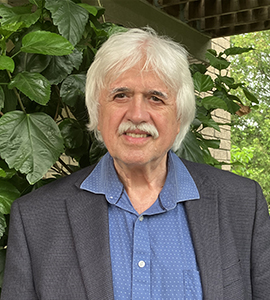In this article, the author reminisces about a cherished relationship with Augusto Graziani, a fellow dissenting economist, academic colleague and friend for almost three decades, by identifying what united them on both a personal level and intellectually, as well as by highlighting some very minor, but lingering, differences in macroeconomic and monetary theory that had persisted over those years.
It is with truly positive feelings and a profound sense of respect that I wish to offer some personal thoughts and reminiscences. I am writing close to the tenth anniversary of the passing of a towering “dissenting” economist and very special friend, Professore Augusto Graziani. Each of us resided on two separate continents and we had lived our lives almost 7,000 km from each other across the Atlantic Ocean, and also Augusto Graziani and I were slightly less than a generation apart in age. Yet, when I first encountered Graziani, it was as if I had met an old friend and a true gentleman by engendering the feeling that I had known him for what seemed as a lifetime, in part because of common friends and acquaintances, but also because we spoke to each other literally using the same language with a very slight Neapolitan twist. Indeed, he continued to make me feel that he was always happy and honoured to retain that friendship every time we met in Italy, for instance, in treating me to the nearby “Lavazza” coffee shop for an espresso or in hosting me for dinner in his favourite restaurant near the University of Rome “La Sapienza”.
I had first heard of Augusto Graziani through another common friend, the late Professeur Alain Parguez, who resided in Paris and who is often considered together with Augusto Graziani as co-founder of the Franco-Italian Circuitist approach to monetary theory. Starting in 1981, Alain Parguez would come regularly to Canada as a visiting professor and then was subsequently appointed as a special adjunct professor at the Department of Economics of the University of Ottawa until the early 2000s. Alain Parguez had met Augusto Graziani at around the same time and had also established a long-lasting relationship until his passing in January 2014. To my understanding, their first probable encounters were at conferences in Paris, such as at the Institut de sciences mathématiques et économiques appliquées (ISMÉA), and possibly even in Dijon because of Graziani’s contact with Bernard Schmitt of the University of Bourgogne. Having met each other at the time and also having carried out a long and fruitful correspondence, Alain Parguez told me much about their common commitments to post-Keynesian/circuitist ideas during those years of the early-to-mid 1980s. This was a period when Augusto Graziani was also involved, inter alia, with Richard Arena, who during those same years was associated with the ISMÉA, and had been working also together with Jan Kregel on a special edited volume in French on the monetary circuit that was eventually published by the Presses Universitaires de France in 1985. However, that special relationship between Alain Parguez and Augusto Graziani blossomed throughout the 1980s when a number of Graziani’s articles in both French and English were published in the series Monnaie et production of the ISMÉA journal Économies et sociétés of which Parguez had been editor between 1984 and 1996.
Like many young heterodox colleagues and students of that era, I too had attended the Trieste Summer School in August of 1983. However, we had missed each other that year, as it was only in 1984 that Augusto Graziani got invited as member of the teaching staff of that well-known school in company of other post-Keynesian economists internationally. In fact, it was not until April 1986 that we actually met in person on this side of the North Atlantic at the annual meetings of the Eastern Economic Association that were held in Philadelphia that year. After that first memorable encounter, we stayed in touch and must have seen each other at least a half-dozen times in either Italy or France. For instance, in the late 1990s and during the early 2000s, whenever I was in Rome, he would ask me to give a lecture to his first-year students, which for me was truly a challenge because I had to communicate effectively in Italian! For instance, the last time that I had given a one-hour lecture, on the nature and evolution of the household saving rate by income groups in late February of 2001, was especially memorable because of the lively discussions with his students that continued long after the allotted lecture time, in fact, even during his office hours that followed the lecture.
This solid and respectful relationship with Augusto Graziani began in 1986 not only because we had common friends and colleagues, especially in France, who subscribed to the monetary circuit approach and rejected neoclassical macroeconomics and monetary theory. Fate had it that our actual places of birth were less than 90 km apart in the southern Italian region of Campania. While he was born in Naples, I was born in a small town in the northern confines of Campania, just adjacent to Mignano-Monte Lungo, after which my family then emigrated in the late 1950s to Montreal, situated at the heart of French-speaking North America. He had explained to me that his father, Alessandro Graziani, had a very special respect and appreciation of Canadian soldiers at the time of the Allied landings in Naples in October 1943 when young Augusto was only ten years old, because his dad knew French sufficiently to communicate well with some special group of French-Canadian soldiers who accompanied the American and British Allied Forces.
Moreover, we had common research and teaching interests not only in macroeconomics and monetary theory, but also in the history of economic thought, particularly in the monetary theories of Marx, Wicksell, and Keynes, and in economic history. This latter field of research also included special concerns about economic development because we both subscribed to dualistic models of economic development and theories of structural heterogeneity. For instance, he had applied these dualistic theories to Italian economic history in explaining the problems of the industrialization of the Mezzogiorno, while I had adopted a hybrid form of these dualistic Lewis models to explain the mid-nineteenth century fragmented industrialization of central Canada that gave rise to a particular economic duality along linguistic lines. There were just so many areas of overlapping interests in both research and teaching that made for productive exchange of ideas. As a junior academic at the time, it offered me so much to learn during that very limited but intense interaction that lasted from approximately 1986 till just before the Global Financial Crisis after which, unfortunately, we had lost any further physical contact.
Where Augusto Graziani and I truly found common interest, however, was in post-Keynesian/circuitist monetary theory, which in many ways had come from my graduate studies in the 1970s at McGill University in Montreal where, as graduate students, we had been very privileged to meet and attend numerous lectures from eminent post-Keynesians, especially Joan Robinson, who would come regularly to visit her daughter in south-western Ontario. Professor Robinson would normally first stop in Montreal, thanks to her close academic relationship with Tom Asimakopulos, who had himself pursued his doctoral studies at Cambridge University during the 1950s. However, there was also a lot more direct intellectual influences coming from my own personal contact with my Canadian departmental colleagues and friends Marc Lavoie and Jacques Henry, as well as my French colleague and friend Alain Parguez throughout the late 1970s and early 1980s. Because of these links, at my various encounters with Graziani in France, Italy and even in the US, this offered a common vocabulary and references as we both subscribed to critical concepts and frameworks of monetary analysis that had as starting point the role of endogenous credit-money in the financing of an economy’s productive process and growth. While innovative in embedding his analysis in the works of Marx’s analysis of the circuit of money capital, Professore Graziani had also been heavily influenced by Keynes’s Treatise on Money and Keynes’s later writings on the “Finance Motive” rather than the strict General Theory framework, which was just too heavily Marshallian with its emphasis on the “stock” demand/supply aspect of money to be of special interest to circuitist theorists. Perhaps having been partly influenced by Alain Parguez from his 1975 book Monnaie et macroéconomie, as well as his later writings, by the 1980s Graziani’s remarkably clear and insightful publications became popularized among post-Keynesians, particularly what became his famous distinction between “initial” versus “final” finance. That key distinction was so crucial in bringing down the complete Hicksian IS-LM macroeconomic edifice, which Joan Robinson had described as “bastard Keynesian” macroeconomics, in a way that no other heterodox post-Keynesian writers perhaps ever did.
While we considered ourselves as true comrades-in-arms who stood against neoclassical macroeconomics and monetary theory, this, however, does not mean that Graziani and I agreed on all aspects of monetary circuit theory. For instance, as I had highlighted in the Deleplace/Nell 1996 book on Money in Motion, there remains the long-standing problem that still afflicts models of the monetary circuit, namely the so-called “profit puzzle” — that is, the recurring question of how can there emerge a flow of monetary profit when all bank loans go solely toward the financing of advances of Marxian variable capital, namely the wage bill, as is found since the 1980s within Graziani’s strict canonical model of the monetary circuit. As many colleagues are aware, I have always respected the logical consistency of Graziani’s essentially non-monetary solution to understanding the flow of profit by formally consolidating the business sector in his aggregative model of the monetary circuit, thereby abstracting from inter-firm purchases that may transit from the banking sector in the form of business financing. Over the years, however, I felt rather uneasy about his solution, as well as that of other post-Keynesians such as Edward Nell, because Graziani’s answer was, in its essence, a non-monetary solution to what is a monetary flow problem. For this reason, I had aligned myself more closely with the position taken by Alain Parguez within the monetary circuit approach, who had already spelled out since the mid-1970s and early 1980s that firms do also finance through bank credit the purchases of equipment goods and raw materials — that is, investment in Marxian constant capital. Even if the latter monetary flows are all eventually cancelled out in the aggregate, albeit not necessarily instantaneously, through inter-firm transactions, this rather more realistic Parguezian assumption would at least assure a monetary flow of profits to all businesses.
In another related debate, it is well known that all circuitist writers had emphasized the importance of credit-money in the financing of capitalist production within an M-C-M’ framework. Traditionally, all these writers generally rejected or, at least, minimized the significance of what circuitist writers, such as Parguez, referred to as a Mengerian stock of money which, at best, is of practical relevance only in the sphere of circulation and not in the sphere of production. However, in a celebrated 1983 article in L’Unità (on the 100th anniversary of Marx’s death) whose translation was subsequently published in English in the International Journal of Political Economy in 1997 (thanks to the immense effort of Riccardo Bellofiore), Graziani did suggest that in societies before the capitalist mode, owing to the absence of wage labour, this Mengerian money may well have been the general form of money, namely that of a pure medium of exchange. In a short article published in the Journal of Economic Issues (written jointly with Eugenia Correa) in 2018, we questioned somewhat Graziani’s position by using as framework Polanyian theory, where money arises as a means of payment with the capacity of extinguishing debt, in which we argued was fully consistent with circuitist theory when including the role of the State along Chartalist lines. Hence, in all organized societies in which there is a State-backed legal system, money always originates as an outcome of a credit-debt relationship — even in, say, ancient slave societies before the capitalist mode. We argued that this Polanyian position appears to be in conflict with the stance taken by Graziani as late as in his 1997 translated article when he alluded to pre-capitalistic economies.
This was all the more interesting because, in an important conference in April 1996 that I had co-organized with Alain Parguez and Bernard Vallageas, we witnessed an uncharacteristically fiery debate between Augusto Graziani and Victoria Chick on exactly this specific question of the institutional evolution of money and the monetary system. At that Paris conference, Chick had presented her famous evolutionary theory of money as the latter had supposedly evolved from simple exogenous commodity-money in the Middle Ages (or what Knut Wicksell had described in 1898 as a pure cash economy), in which “non-barter” money first appeared for purely transactions purposes as a simple medium of exchange, toward a pure endogenous credit-money world (or a Wicksellian-type pure credit economy) already by the twentieth century. At the 1996 conference, Graziani was extremely critical of Victoria Chick because he thought that what she was describing in her evolutionary analysis was nothing more than a pseudo-history of money. From my understanding of Graziani’s intervention at the 1996 Paris conference, money for him was always in the nature of credit-money. In fact, I remember vividly, at one point, when he mentioned that even if we were to adopt “pigs” as monetary unit of exchange, it would not affect the true nature of money, unless we are trying to describe what is still a barter exchange system pretending to be a “monetary” economy. While I, together with Parguez and Vallageas at the time, were very much in agreement with Graziani’s criticism of Chick’s “stages” view, his position taken in that original L’Unità 1983 article, previously discussed, did not completely square with what he had defended in his intensely-animated 1996 debate with Victoria Chick. Since our 2018 paper was written and published after his death, I never was able to discuss with him if he was still comfortable with his 1983 position on the critical institutional significance of wage labour for the existence of credit-money, or if he would have sympathized with the Polanyian view of money that Eugenia Correa and I had described in 2018. Perhaps he had changed his views and wrote about it, but I remain unaware of how these distinct 1983 and 1996 positions came to be reconciled, if ever, by Graziani.
In contrast, on another issue, which I had actually discussed and debated even directly with Augusto Graziani over the years, this is on a specific question arising already from my original 1984 paper in the first issue of Monnaie et production. Unlike my own evolution, I had contended that he had perhaps remained too strongly influenced by a strict neo-Wicksellian “demand-side” pricing theory and not sufficiently by cost-based Kaleckian markup theory. The neo-Wicksellian theoretical perspective to which he subscribed in all of his major works can lead to an explanation of inflation that may be somewhat misleading, that is, by not emphasizing sufficiently what could be described as a more realistic Kaleckian modelling of the markup-pricing process, which has been so hotly debated among heterodox economists even during this recent pandemic inflation surge internationally. This latter problem in Graziani’s theoretical model, which is not only specific to him but also to Hyman Minsky’s theory of aggregate price formation and inflation, has been discussed in a recent contribution to a special memorial publication dedicated to the oeuvre of Alain Parguez in the Fall/Winter 2023 issue of the International Journal of Political Economy. The reason why I was especially troubled by such concern was not so much because, for example, Graziani’s pricing model would normally associate a private-sector cyclical investment boom with increasing inflationary pressures, largely, say, because of the significance of demand-sensitive primary commodity prices. Rather, it is mostly because the analysis can lead inevitably to a more perilous macroeconomic policy conclusion. This is because, in his model, all deficit spending is inflationary regardless of capacity utilization. This view is undoubtedly very problematic and contentious among post-Keynesian economists internationally, especially nowadays when right-wing policymakers blame the current bout of inflation on the supposed “excessive” budgetary deficit spending and “monetization” originating from the early COVID-19 pandemic period of 2020-2021. Given these two distinct points of view on aggregate price formation and inflation, would Graziani have held this same position today or, instead, would he side with Kaleckians given the very recent experience with inflation?
This previous discussion over the convergence/divergence in our research positions, in some ways, brings to the fore what I would like to describe as my deep regret in not having been in sufficient contact and proximity within Graziani’s research circle over those almost three decades that I had known him so as to collaborate directly on a special shared research endeavour. Given the evolution of the economics profession, perhaps naively, I am one who still believes that, outside of the realms of ideology and religion, it is only through actual research work and confrontation with the “facts” (rather than, say, axiomatic theorizing) that one can meaningfully clarify what is the most appropriate explanation of physical and social reality, for instance, of aggregate pricing behaviour. Admittedly, my only attempt to have Graziani involved in some type of collaborative research project, which regrettably ended in failure, was just after that 1996 conference in Paris to which I have previously referred.
At the time, Bernard Vallageas and I had asked conference participants to submit copies of their final papers so that we could try to publish a special journal issue to popularize monetary circuit theory. After a special organized session on the monetary circuit at the Eastern Economic Association meetings in New York in February 1997, Bernard and I had approached Steven Pressman, who was then one of the two co-editors, together with Gary Mongiovi, of the Review of Political Economy with the proposal of pulling together some of the papers that had been presented at the 1996 Paris meeting for precisely the purpose of putting together a special issue on the theme of the conference. Although Graziani told me that he was initially unable to contribute a paper, I was able to convince him to provide us, instead, with a special piece in English inspired by what he had written as introduction to his 1994 book, La teoria monetaria della produzione, which he was happy to do, since I had offered to use it specifically as an introductory piece for the planned special issue. After collecting and bundling all the papers, I sent them to Steve Pressman and had requested that, as much as possible, they should be evaluated by the same two reviewers so that they could judge not only the quality of each paper but also how these papers would fit together in a special issue rather than treating them simply as individual stand-alone submissions. At the time, Pressman whom I knew and had collaborated with him and Marc Lavoie on a similar special issue project in that journal published in 1995 from a previous conference held at the University of Ottawa in 1994, did not quite follow that recommendation. He simply sent all the papers to separate reviewers seemingly with no special attention being given to Graziani’s introductory piece, which was clearly understood from the beginning that it could not be published as a stand-alone paper, but which was valuable only as a solid introductory article. Predictably, Graziani’s submission was deemed of poor quality and was outrightly rejected by the anonymous reviewers. The editor then sent him directly the negative reports and only informed me of this when, in a sense, damage to my relation with Augusto Graziani was already done.
Given my personal embarrassment, the rest of what happened is history, because at the time I could no longer proceed with the special project. In response to what had occurred with Graziani, Vallageas and I left it to individual authors, whose papers had been accepted, by recommending to publish them as they wished in either that specific journal or elsewhere. Hence, a couple of those papers, such as the joint one by Riccardo Bellofiore, Guglielmo Forges Davanzati and Riccardo Realfonzo as well as the one by Jean-François Renaud were published separately in the Review of Political Economy in 2000 as stand-alone articles. But, my own paper and that of others from that original 1996 conference were subsequently published elsewhere — in my case, in the book on Modern Theories of Money edited by Louis-Philippe Rochon and Sergio Rossi in 2003. Indeed, in retrospect, it can be said that even another version of that introductory piece was published subsequently as chapter in a well-known English publication of the Federico Caffè Lecture Series, The Monetary Theory of Production, by Cambridge University Press in 2003. However, given the embarrassing experience with how his submission had been treated, I found it rather difficult to approach Graziani again by involving him on a similar research project, even after I became editor of the International Journal Political Economy now some 20 years ago. I did have the opportunity to explain to him what had happened with his paper submission during one of my trips to Rome in 2001 and, of course, we continued to be solid friends, as was the case, when we saw each other subsequently, as during the Benevento conference organized by Giuseppe Fontana and Riccardo Realfonzo in honour of Augusto Graziani in December 2003. However, what had transpired with that journal project was a truly painful experience for both of us because of my deep admiration for his work and the persona.
Despite these challenges and differences among post-Keynesian/circuitists that I have recounted, I believe that these were differences among friends that should in no way take away the fundamental importance of all our accomplishments. There is a well-known saying that we build our ideas and we progress intellectually by honest debate and criticism while still standing on the shoulders of giants. Augusto Graziani was most certainly one of those intellectual giants whom I was privileged to have known and who very much influenced my thinking over the many years. He shall forever be remembered for his many personal and intellectual achievements, especially in monetary economics, and per la sua sincera amicizia.



